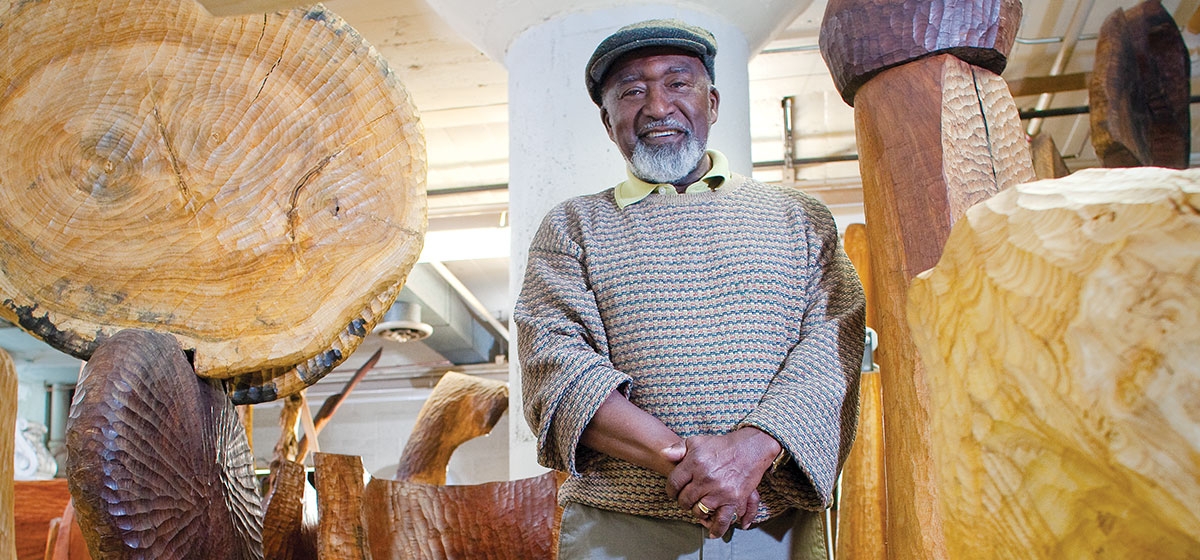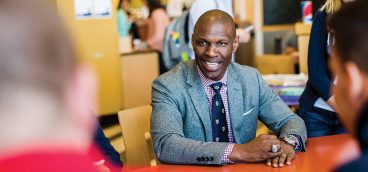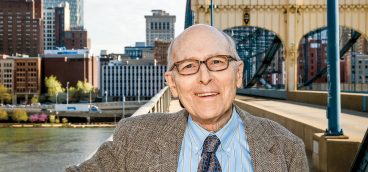
Art is about personal expression. Anyone who discovers and practices this has something to live for other than what they have to do to make a living. People who write poetry don’t make a lot of money, but seeing their words on the page provides more satisfaction than any job could offer.
It’s the same for a sculptor like me. I worked for the post office. As soon as I got out of there, I went home, cooked dinner for my kids, saw to it that their homework was done, and then headed to the studio. Friends often asked, “How can you do all of that after work? I don’t feel like doing anything.” I would tell them that they were bored, and had become accustomed to being bored.
I was born in New Castle, a small industrial town, and raised in and around that area, more or less. My dad worked in the coal mines for about 40 years. My mother was a seamstress. In those days, the companies moved miners around as certain mines went down and others opened for work. There were four girls and me—I was next to the last—and we all felt very isolated in that small town, especially my mother. She wanted something more, so she took a job and moved from Number Five Mine, near Grove City (where I started school), to New Castle. The separation was hard on my parents and, as a result, when I was about 8 years old, they were divorced.
When I was a little kid, I made up my mind that the mines just weren’t for me. I used to cross a field to see my father come up from underground, and that was enough. I was an honors student in high school. I was always intellectually curious. My dad had a small collection of books and believed in learning, so he was happy that I was going to school and doing very well.
After high school, I served a hitch in the U.S. Navy. When I first came out of the service, I was stationed for a time in New York, which has always been my favorite spot. I wanted to go to Columbia University, but they weren’t taking out-of-state students back then. If they had been, I probably would have stayed in New York. Of course, if you don’t have a lot of money—and I didn’t—Pittsburgh’s a better place to live because it’s on a smaller scale and much more affordable. So for me, it kind of worked out all right, settling here.
I came here in 1946 to study English and journalism at the University of Pittsburgh. I’ve been here ever since. Pitt, in those days, was like most places in western Pennsylvania. There were few Afro-Americans and no Afro-American instructors or professors. The only black workers at the university were service employees. Fraternities were segregated, but I was never much into that sort of life. Sure, this bothered me. Here’s a fact that really tells the tale of that time in western Pennsylvania: a number of young black men graduated with degrees in engineering, and most of them left town because they couldn’t get jobs in their field in Pittsburgh.
I don’t know if there is a really “good” place for an artist to live. The life can be very difficult. At least in Pittsburgh you can get cheap studio space. But if you’re thinking about selling your work, it can be tough. People here think things should be cheap. I know people who have gone to New York and, unknowingly, bought the work of Pittsburgh artists at three or four times the prices they would have paid for it at home. It’s the “prestige factor” of the New York scene, I suppose.
After college, I took a part-time job at the Pittsburgh Courier, covered a lot of sports and helped out with photography. Then I managed to get work at the post office. At that time, there was something called the Postal Transportation Service. We worked the trains, moving parcels, letters and magazines. Well, I stayed on there for the next 40 years. It wasn’t that I was enamored with the job. It was a means to an end. Many people, such as the great bassist Charles Mingus, worked for the U.S. Postal Service in some capacity in those days. We didn’t have to worry if payday was coming. We did our art or music after hours and on weekends.
I work mostly in wood, so the kind of art I make is hard to produce in a place like New York, anyway. In western Pennsylvania, there are a lot of saw mills, so there’s always a lot of wood. When I first started, I wasn’t too particular about the type of wood I used. Basically, I would carve anything.
Early on, I got interested in African tribal art and Scandinavian design, just from reading and spending time at the Carnegie Museum. I started making figures and heads and, from there, got into abstraction and started entering shows. I would say that my career followed a natural course.
I just made little things at first, a lot of stuff that I never showed. I made things for myself (and still do). But in the mid-1950s, I started making things that I later showed and, in the early ’60s, I joined some art organizations like the Pittsburgh Society of Sculptors. Back in those days, there were almost no galleries in Pittsburgh, except for what I call “salon galleries.” The Pittsburgh Center for the Arts was the main institution for local artists. Of course, there was the annual show at the Carnegie, which was a really big deal. Every artist wanted to get into that.
Once in a while, if you were well-known, you’d get a shot at a show at the Carnegie—a small, single-artist show— when Leon Arkus was the director there. But most of their shows were group shows, so you kept working towards them. Anyway, in 1966, Leon offered me my first major show at the Carnegie Museum of Art. I worked for two years and it went up in 1968.
I’m a great lover of jazz, and I’ve met many jazz musicians in my time, even worked with some. They made a lot of music, but never made much money. I think that could be said for most people in the arts. You try to make some sort of life for yourself. You do the best you can. For some, it works out. For others, it doesn’t. As a result, you can drown in bitterness, if that’s what you want to do. Many people have, feeling that they’ve been cheated. They become victims and they get into drugs or drinking. I know people that graduated from Pitt and could only get jobs at the post office. Some went into social work for the Department of Welfare. Many felt that life had dealt them a raw deal. I never really felt that way because I had my art, I suppose. That is who I am.
Pittsburgh is about the same as any city its size when it comes to race relations and opportunities for all. Things have changed, but very slowly. Every city has small groups of blacks who gain prominence, but what you don’t see is prosperity for the masses. That’s the legacy of slavery: ghetto-ization. And that situation has stunted the growth of many, many Afro-Americans. The ghettos, from Los Angeles to New York, are mirror images of each other. You could drop people in those sections of either city and, except for the climate, they wouldn’t know the difference. I’m not a social psychologist, but I know that ghetto life is bad. Most people have never owned anything and develop a hopeless “ghetto mentality.”
My oldest son lives in Oak Park, outside of Chicago. The one thing they do there is to try not to have several black or Hispanic or Arab families living in a row. When people come to buy houses, if they’re members of a minority group, the city tries to incorporate them into the neighborhood so as not to create small ghettos here or small ghettos there. It’s a smart thing to do.
I think artists have a personal perspective, a vision, something they want to see. In my old age, a lot of times I don’t feel like cleaning the house or doing stuff like that, but I always, unless I’m sick, feel like going to the studio. I always believe that I’m going to do something better than I’ve done before. Maybe it doesn’t happen, but it is a challenge and that brings personal satisfaction.
I was married twice and have six children. My oldest son is 62. He is a chemist in pharmaceuticals and has done well. My oldest daughter is in respiratory therapy. She’s a professor at a school hospital in Chicago. Their younger sister is a senior accountant. My daughter from my second marriage went to Drexel and got her master’s degree at Kenyatta University in Kenya. She was in advertising. Now she’s got her sights set on being a dress designer. I have another son who’s a painter. There’s lots of his stuff around. My youngest son, Khari Mosley, who most people know better than they know anyone else in this family, is in politics.
After my second wife and I broke up, the kids were with me. Their mother made very few demands on them. As long as they were happy, she was, too. But I wasn’t. I was a tough dad. My kids didn’t have to do what I wanted them to do, but they had to do something. I remember my youngest coming home after school one day and heading for the door. I said, “Where are you going?” He said, “Out. I don’t have any homework.” “Yes you do,” I said. “You got a ‘C’ in English last time. You have English homework—every day.” One of my daughters said to me recently, “Daddy, when we were little, we thought you were mean. But now we see where we are and compare that to where our old friends are…” And there’s a world of difference, believe me.
My definition of success comes in the form of a question: How are you able to handle your life? I don’t care how much money you make or what big name you have. If you’re not able to handle your own life, success has somehow eluded you. My kids and I, we can handle our lives, and I’m really proud of that. We have achieved a sense of satisfaction about who we are and what we are.
The exhibit: “Sculptures by Thaddeus G. Mosley” is on view downtown at the August Wilson Center.





